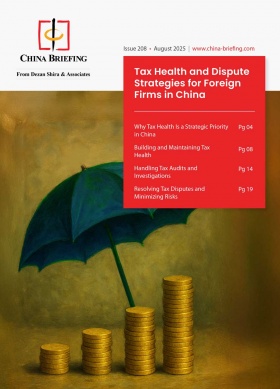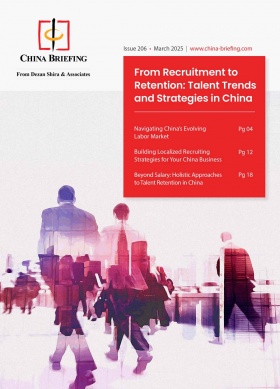China’s Biopharma Industry Clusters: Mapping Opportunities and Regional Strengths
China’s biopharma industry has rapidly evolved from a generics hub to a global innovation leader, fueled by strong policy support, expanding R&D, and a vast healthcare market. Regional clusters form a solid base for the industry’s research, commercialization, and global integration, while offering growing opportunities for foreign firms.
China’s biopharma industry (sometimes referred in policy and technical literature as “biopharmaceutical industry”) has emerged as one of the country’s most dynamic and strategically important sectors, driven by strong policy support, expanding R&D capabilities, and a rapidly growing domestic healthcare market.
In recent years, the government has prioritized the development of biopharma clusters across the country to strengthen innovation capacity, accelerate the commercialization of research, and integrate China more deeply into global value chains.
For instance, on August 21, 2025, the State Council gave further momentum to this trajectory by approving the Plan for Open and Innovative Development of the Entire Biopharmaceutical Industry Chain in the China (Jiangsu) Pilot Free Trade Zone. The initiative, submitted by the Jiangsu Provincial Government and the Ministry of Commerce (MOFCOM), aims to establish a globally influential industrial cluster by advancing integrated innovation across the full biopharma value chain.
This move underscores both the central government’s commitment to regional cluster-building and Jiangsu’s growing importance as a hub within the Yangtze River Delta.
In this article, we examine where China’s main biopharmaceutical clusters are located, the defining features of these hubs, and the policies and incentives shaping their growth. We also highlight the opportunities these clusters create for foreign firms — from research collaboration and clinical trials to commercialization and investment partnerships — within China’s rapidly evolving biopharma landscape.
China’s biopharma industry andscape
Over the past decade, China’s pharmaceutical industry has undergone a profound transformation, moving from a supporting role in global supply chains to an emerging leader in biopharma innovation. Once regarded primarily as a low-cost base for producing generic drugs and active pharmaceutical ingredients (APIs), China is now making its mark across the full value chain.
This shift from “Made in China” to “Created in China” reflects not only a change in government priorities but also the rapid maturation of China’s innovation ecosystem. Today, Chinese firms are increasingly recognized on the international stage for their novel drug candidates and breakthrough therapies.
By 2024, China accounted for nearly one-quarter of next-generation therapeutic candidates worldwide, and out-licensing deals, where Chinese companies export their innovations for global commercializatio, surgedfrom just US$8 billion in 2020 to over US$50 billion in 2024. Landmark developments, such as Akeso Inc.’s monoclonal antibody that outperformed Merck’s Keytruda in early clinical trials, highlight China’s growing competitiveness in high-value therapeutic areas, including antibody drug conjugates, CAR-T cell therapies, and genetic sequencing.
Key factors behind China’s biopharma growth
Several factors underpin this ascent in China’s biopharma sector.
First, government support has been consistent and long-term, with strategies like Made in China 2025, Healthy China 2030, and the 14th Five-Year Plan for Pharma Development explicitly positioning biopharma as a pillar industry.
Regulatory reforms have accelerated drug approvals, cutting median review times to just over fifteen months and significantly shortening the pathway for new drugs to be added to the National Reimbursement Drug List (NRDL). These measures have reduced the traditional “drug lag” between global markets and China, enabling faster access for patients and quicker commercialization for companies. At the same time, China has dramatically expanded its research and development capacity.
National R&D spending has already surpassed that of the European Union and is closing in on US levels. In biopharma specifically, investment grew from a modest US$35 million in 2015 to nearly US$15 billion in 2023. This is complemented by a large and increasingly skilled talent pool. China now produces millions of science graduates annually, while a “reverse brain drain” sees many Chinese-born scientists returning after years in leading Western laboratories and companies.
The country’s vast domestic market provides another decisive advantage. As the world’s second-largest pharmaceutical market, driven by an aging population and rising chronic disease rates, China offers both scale and diversity for clinical research. Clinical trials in China are estimated to cost 30 to 40 percent less than in the U.S. or EU, thanks to lower operating expenses, faster patient recruitment, and advanced medical infrastructure concentrated in major cities. These conditions have made China a global hub for clinical studies: in 2023, nearly 40 percent of all new clinical trials worldwide included a Chinese site, up from one-quarter in 2019.
Scale of the sector: market size, global ranking, R&D spending
China’s biopharma industry has expanded at a pace unmatched by most other sectors in the country’s healthcare system. What was once a niche subsector has rapidly become one of the largest and most dynamic components of China’s innovation economy. The market capitalization of Chinese biopharma firms surged from just US$1 billion in 2016 to over US$200 billion by 2020, reflecting both investor confidence and the accelerating commercialization of homegrown innovation. The COVID-19 pandemic further highlighted this trend, as several Chinese companies successfully developed and deployed vaccines that are now used globally, boosting the industry’s profile both domestically and abroad.
The underlying market fundamentals suggest this growth trajectory will continue. China’s healthcare market overall is projected to more than double, rising from US$900 billion (RMB 6.47 trillion) in 2019 to US$2.3 trillion (RMB 16.53 trillion) by 2030. Moreover, healthcare expenditure as a share of GDP has also risen steadily, from 4.23 percent in 2010 to 5.35 percent in 2019, underscoring the sector’s growing economic weight.
Within this broader expansion, the biopharma segment is expected to see particularly strong growth. Industry revenues are projected to increase from RMB 345.7 billion (US$ 47.6 billion) in 2020 to RMB 811.6 billion (US$111.8 billion) in 2025, a remarkable 135 percent rise in just five years. This growth has been accompanied by a rapid increase in new entrants: between 2010 and 2020, 141 new drug and biotech companies have been launched in China, double the number formed in the previous decade.
For investors and foreign companies, these figures highlight both the scale of opportunity and the competitive intensity of the Chinese biopharma landscape. The industry’s growth is underpinned by powerful demand-side drivers, ensuring that innovation, investment, and policy support will remain central features of China’s healthcare trajectory in the years to come.
China’s major biopharma industry clusters
Beijing-Tianjin-Hebei (BTH)
The BTH cluster functions as the academic and research heart of the nation, leveraging unparalleled educational resources and a vast talent pool to drive foundational R&D. The development of the BTH biopharma cluster is a direct outcome of a major national strategy initiated in 2015, namely, the BTH Coordinated Development. The policy’s core objective is to alleviate the “big city disease” of Beijing by orderly transferring its “non-capital functions” to the surrounding areas of Tianjin and Hebei.
The BTH cluster’s primary competitive advantage lies in its concentration of academic excellence and research infrastructure. A prime example is the Zhongguancun Life Science Park, situated in Beijing’s Changping District. It is positioned as a globally leading “Life Valley” and serves as a critical support platform for Beijing’s International Science and Technology Innovation Center. The park as a whole is an active and thriving ecosystem. It has attracted numerous internationally renowned scientific institutions, including the National Institute of Biological Sciences, the Chinese Institute for Brain Research, and the National Center for Protein Science. This concentration of top-tier talent and resources from academia provides the essential foundation for groundbreaking research.
Another cornerstone is the Peking University School of Pharmaceutical Sciences (SPS), one of China’s premier institutions for pharmaceutical education. The school actively undertakes numerous key research programs, has secured over 120 patents, and has published more than 1,500 research papers in the last five years. This robust academic base ensures a continuous pipeline of highly skilled talent and novel research.
Notably, the BTH cluster is home to a mix of both prominent multinational and domestic biopharma companies that specialize in R&D. International firms like Novo Nordisk have established a presence, as have leading Chinese innovators such as BeiGene and InnoCare. The presence of these companies further solidifies the cluster’s position as a hub for both basic research and its translation into clinical applications, reinforcing its unique R&D-centric specialization.
Yangtze River Delta (YRD)
The YRD cluster, encompassing Shanghai, Jiangsu, Zhejiang, and Anhui, has established itself as China’s most dynamic and commercially comprehensive biopharma ecosystem. Dubbed the “Golden Corridor,” the region’s synthetic biology and biomanufacturing sectors have witnessed explosive growth, with annual revenue soaring from RMB 29 billion (US$4.06 billion) in 2022 to over RMB 90 billion (US$12.62 billion) in 2024, a 213 percent increase.
This rapid expansion is fueled by the strategic integration of next-generation technologies. The YRD’s pioneers are at the forefront of merging AI with synthetic biology, which significantly streamlines R&D and accelerates the industrial scale-up of new products. The development of automated pilot production lines allows for the rapid transformation of research concepts into market-ready solutions. This technological convergence is a powerful competitive advantage that sets the YRD apart.
A key driver of the YRD’s success is its role as a national proving ground for institutional reform through pilot Free Trade Zones (FTZs). The China (Shanghai) Pilot FTZ is a national demonstration zone for institutional opening-up, with 77 pilot measures being replicated nationwide. These measures span critical areas for biopharma, including services trade, intellectual property protection, and digital trade.
Moreover, the YRD’s competitive advantage is overwhelmingly due to its concentration of human capital. A study of R&D professionals in China’s biopharma sector found that the YRD accounts for 70.3 percent of the talent pool, with Shanghai alone holding a dominant 57.4 percent share. This concentration of talent creates a powerful network effect, fostering collaboration and innovation.
The cluster is home to a high concentration of leading companies, such as WuXi Biologics, Shanghai Junshi Biosciences, and Shanghai Henlius Biotech, reinforcing its status as a commercial and manufacturing leader.
Case study: Jiangsu FTZ Biopharma Plan
On August 21, 2025, the State Council approved a landmark strategy to elevate the Jiangsu Pilot Free Trade Zone (FTZ) into a national biopharmaceutical innovation engine. To accelerate integrated innovation and development across the entire value chain, the plan prioritizes strengthening R&D capabilities, faster product approvals, advanced production and distribution systems, and optimized procurement policies.
By 2030, the vision for Jiangsu’s biopharma sector includes scale expansion, a robust innovation ecosystem, sophisticated industrial infrastructure, and specialized clusters in areas such as macromolecular biologics, cell and gene therapies, and cutting-edge medical devices.
Greater Bay Area (GBA)
The GBA is a unique biopharma cluster, not defined by a single city but by an integrated economic zone that includes nine cities in Guangdong province and the Special Administrative Regions of Hong Kong and Macao. With a population of over 86 million and a GDP exceeding RMB 14 trillion (US$1.9 trillion), the GBA is an economic powerhouse. Its primary value proposition for the biopharma sector is its unparalleled institutional framework for cross-border collaboration and market access.
The core of this framework is the Work Plan for Regulatory Innovation and Development of Pharmaceutical and Medical Device in the Guangdong-Hong Kong-Macao Greater Bay Area. This plan creates a unique “regulatory sandbox” that allows Hong Kong-registered drugs and medical devices to be used in designated GBA hospitals without requiring full approval from the Chinese National Medical Products Administration (NMPA). This policy provides a direct, streamlined pathway for products to reach an 86-million-person market. This process not only accelerates market entry but also enables the collection of crucial real-world evidence (RWE), which can be leveraged for future, broader regulatory approvals in mainland China.
For foreign companies, the GBA’s unique institutional arrangement offers a low-risk gateway to test and validate products in the Chinese market. On top of this, the GBA has rapidly emerged as a key hub for clinical trials. The newly established Greater Bay Area International Clinical Trial Institute (GBAICTI), launched in the Hetao Shenzhen-Hong Kong Science and Technology Innovation Cooperation Zone, is a prime example of this. This institute aims to enhance Hong Kong’s clinical trial capability, expedite the approval of new drugs, and attract top-tier innovative enterprises.
The GBA’s entrepreneurial ecosystem is also one of a kind, profoundly influenced by the region’s concentration of technology giants like Tencent and Huawei. This synergy between tech and biotech has created a fertile ground for startups focused on areas ranging from traditional oncology to AI-enabled bioprocessing platforms and even cultivated meat. Companies like Great Bay Bio, which has developed AI-enabled platforms for cell line development, exemplify this tech-bio synergy.
Emerging and specialized hubs: Chengdu-Chongqing and Wuhan
The Chengdu–Chongqing region has become the leading biopharmaceutical hub in Western China, supported by the national “Western Development Drive.” Its growing role is evident in the arrival of international service providers such as Gempex, which opened a Chengdu office to form a “Golden Triangle” network with Guangzhou and Suzhou, offering global-standard GMP solutions for life science companies in Southwest China. This development signals the region’s evolution from an emerging cluster into a mature ecosystem equipped with the infrastructure to support advanced biopharma operations.
Wuhan, by contrast, exemplifies a hybrid model that combines state-owned industrial capacity with private innovation. The Wuhan Institute of Biological Products, under Sinopharm, anchors large-scale vaccine and biologics production, while firms like YZY Biopharma drive cutting-edge research in bispecific antibody therapies. This mix enables Wuhan to align national health objectives with entrepreneurial innovation, attracting internationally trained talent and building a diversified pipeline.
Strategic outlook
All in all, China’s biopharma industry is entering a new phase of regional specialization, with each cluster contributing distinct strengths to the national innovation landscape. The BTH region anchors basic research and early-stage discovery, the YRD drives commercialization and large-scale manufacturing, and the GBA connects China to global markets through its unique regulatory and institutional framework.
Emerging hubs such as Chengdu–Chongqing and Wuhan complement this network with cost-effective operations, state-backed capacity, and private-sector innovation. While the industry benefits from strong policy support, a vast domestic market, and rising global competitiveness, challenges remain in talent retention, sustaining long-term innovation, and navigating geopolitical pressures. For foreign firms, opportunities lie in aligning with these regional specializations, leveraging FTZ policies, and pursuing partnerships.
Together, these dynamics position China as an increasingly influential player in the global biopharmaceutical industry.
About Us
China Briefing is one of five regional Asia Briefing publications, supported by Dezan Shira & Associates. For a complimentary subscription to China Briefing’s content products, please click here.
Dezan Shira & Associates assists foreign investors into China and has done so since 1992 through offices in Beijing, Tianjin, Dalian, Qingdao, Shanghai, Hangzhou, Ningbo, Suzhou, Guangzhou, Haikou, Zhongshan, Shenzhen, and Hong Kong. We also have offices in Vietnam, Indonesia, Singapore, United States, Germany, Italy, India, and Dubai (UAE) and partner firms assisting foreign investors in The Philippines, Malaysia, Thailand, Bangladesh, and Australia. For assistance in China, please contact the firm at china@dezshira.com or visit our website at www.dezshira.com.
- Previous Article China’s Visa-Free Policies: Latest Updates
- Next Article European SMEs in China: Insights from the EU SME Centre 2025/2026 Survey








